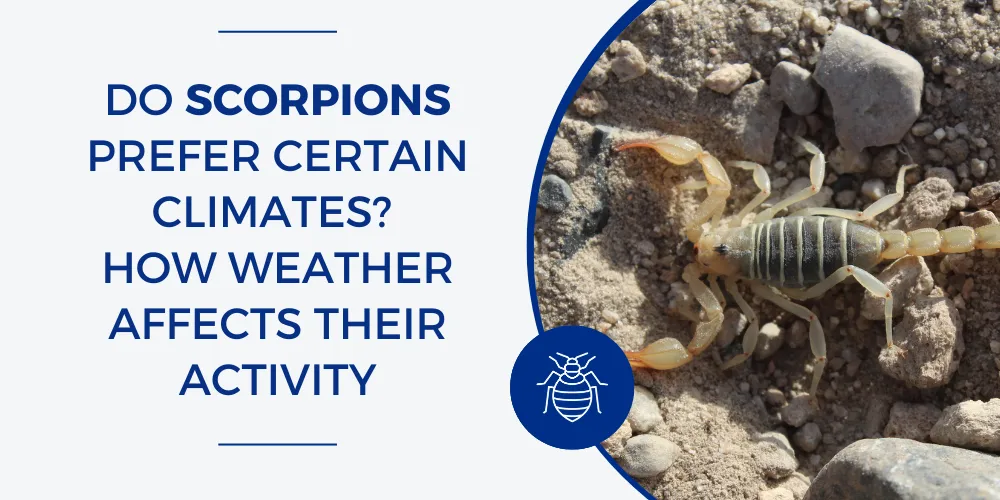Scorpions are highly flexible creatures, but their activity and survival are closely related to the climate around them. These are associated with hot, arid deserts; they can thrive in a variety of places, from semi-arid grasslands to subtropical regions, provided the surrounding environment meets their needs.
Understanding how climate and weather affect scorpions is key to knowing where they are most active and how they live in or move around
Understanding Arizona’s Scorpion Problem
Homeowners often spot scorpions in Phoenix, Arizona, especially as warm nights stretch well into autumn.
Updated guidance from the Arizona Game and Fish Department this summer highlights what many residents have already noticed, scorpion season in Arizona typically runs from March through October.
Urban pockets such as Phoenix, Mesa, Gilbert, and Scottsdale stay warm well into the year, and watered yards create small oases that draw scorpions closer to homes. Reports of multiple sightings in a single week during early June are unsettling but not unexpected.
Scorpion Basics: Why Climate Matters
Scorpions are cold-blooded. Their body temperature is tied to the air and soil around them, which means they lean on external heat to function. Dry, warm places pull them in, yet they still need moisture to survive.
That’s why a Phoenix home with a cool interior, a backyard pool, and a well-watered garden can feel like a perfect mix of dry enough outside, damp enough in hidden corners.
Seasonal Behavior of Scorpions in Arizona
Spring (Mar–May)
They start emerging from winter hideaways. This is mating and hunting time, a quiet buildup before the frenzy of summer.
Summer (Jun–Aug)
This is the heart of scorpion season in Phoenix. Warm nights, often above 90°F, keep them moving. You’ll see them most at night, quick and deliberate.
Fall (Sep–Nov)
Activity slides downward. They begin searching for shelter, often indoors. Think attics, basements, and gaps behind baseboards.
Winter (Dec–Feb)
Many people wonder where scorpions go in winter. They don’t disappear; they retreat indoors, hiding in walls and insulation. You might not notice them, but they’re there quietly, conserving energy.
| Season | Activity Level | Behavior Traits | Indoor Risk | Visibility |
| Spring | Moderate | Emerging, mating, foraging | Medium | Increasing |
| Summer | High | Peak activity, fast movement | High | High |
| Fall | Declining | Seeking shelter | Medium | Medium |
| Winter | Low | Dormant, hidden | High | Low |
How Weather Conditions Affect Activity
Temperature drives almost everything. Between 85–105°F, scorpions are lively, hunting, and exploring. Reports of scorpions in Phoenix spike after monsoon rains when underground burrows flood.
When cold nights arrive, they slip indoors. It’s not always a neat transition; a sudden warm spell in January might coax a few out early.
Common Indoor Hiding Spots (Especially in Winter)
- Under Sinks and Cabinets: Warm, damp areas beneath kitchen and bathroom sinks are prime shelters for scorpions.
- Behind Baseboards and Moulding: Narrow gaps provide dark, undisturbed spaces for hiding.
- Attics and Crawl Spaces: Insulation and stored items create a quiet environment for winter retreats.
- Closets and Storage Rooms: Piles of clothes or boxes give scorpions easy cover.
- Inside Shoes or Clothing: Any item left on the floor, especially in dark corners, can become a hiding spot.
Find Out What are scorpions attracted to?
How to Get Rid of Scorpions - DIY Tips
If you prefer DIY home pest control, it’s possible to stay ahead of them.
Indoor Steps
- Sweep a UV flashlight across floors and walls at night, and scorpions glow faintly.
- Apply a scorpion specific insecticide dust in wall voids and along baseboards.
- Place sticky traps near walls and dark corners.
- Seal gaps: weatherstripping, door sweeps, screened vents.
Outdoor Steps
- Spread granular or liquid insecticide around the perimeter each month.
- Remove debris, stacked wood, and dense ground cover.
- Keep the yard dry, repair leaky hoses, and avoid heavy night watering.
For more, see Bug & Weed Mart’s guide on how to get rid of scorpions or their DIY pest control products suited for pest control in Phoenix, AZ conditions.
Pick up professional-grade pest control products at any Bug & Weed Mart location.
Prevention Tips for All Seasons
Follow these steps on how to keep scorpions out of your house to stay ahead year-round.
- Seal Entry Points: Caulk or weather strip gaps around doors, windows, and vents so scorpions can’t slip inside.
- Remove Outdoor Hiding Spots: Keep firewood, rocks, and yard debris away from exterior walls; trim shrubs and tall grass.
- Reduce Indoor Clutter: Avoid leaving clothes, towels, or shoes on the floor where scorpions can hide.
- Limit Moisture: Fix leaky hoses, elevate pet food and water dishes at night, and avoid heavy evening watering.
- Use UV Flashlights: Check dark corners and baseboards regularly scorpions glow faintly under black light.
- Refresh Barriers: Apply perimeter insecticide or diatomaceous earth every few weeks for added protection.
These simple steps, done consistently, keep scorpions from finding shelter year-round.
Conclusion
Scorpions move with the climate, not randomly. They follow a rhythm: summer surges, winter retreats. Understanding that pattern lets you cut off entry points before they settle in.
Regular DIY treatments, a few careful habits, and you can stay ahead. Maybe not perfectly. But enough to sleep without checking every corner twice.
For free, friendly advice and the right scorpion pest control Phoenix products, stop by Bug & Weed Mart in Gilbert, Mesa, or Phoenix. Bug & Weed Mart has supplied DIY pest control Arizona homeowners trust for over 40 years.
FAQs
They’re at their most active, hunting and mating during warm nights.
Yes. Sensory hairs pick up subtle temperature changes and vibrations.
Often. Monsoon rains flood their hiding spots and send them into homes and yards.
A mix: seal entry points, use perimeter insecticide, and check indoors with a UV light.
Moisture, available insects, and dark, undisturbed hiding spots like firewood piles or cluttered closets

